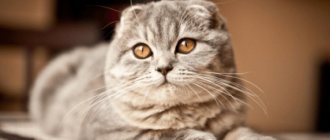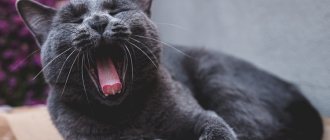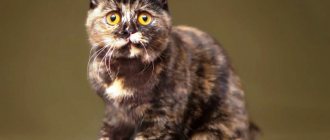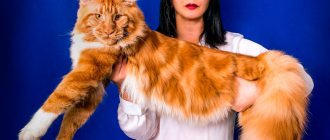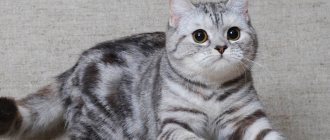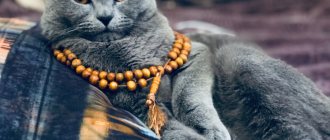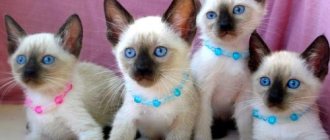In Canadian cats, the body is covered with small and soft hair, which appears on the face, paws and tail. Don fur seals are divided into several types:
- hairless;
- flock - at birth there is a small fluff on the body, which is then wiped off;
- velor—cannon length maximum 3 mm;
- brush - the fur is hard, the head and neck are bald.
Cats' skin is delicate and elastic, folds in some places, and is very warm and pleasant to the touch. Despite their naked body, Sphynx cats are not hypoallergenic breeds, since the human body reacts to the skin secretions of these animals.
The weight of pets is from 2.5 to 5 kg, height - up to 30 cm at the withers. In favorable conditions, sphinxes live 15-19 years.
Origin
The gene that leads to the absence of fur in a cat has been manifesting itself for a long time. Hairless kittens have occasionally been born to representatives of various cat breeds. The owners perceived such pets as a funny misunderstanding.
The first described pair of hairless pets was bought by Mr. Shinnik in Mexico from local Indians. The owner was unable to obtain offspring from the strange animals, but left a detailed description of the animals, which made further research possible.
Soon a hypothesis arose that hairless seals are descendants of animals brought from Europe to South America in the 15th century. The loss of wool could be provoked by a sharp change in climatic conditions.
Later, in the 20th century, Siamese cats living in France began to have kittens without hair. Breeders tried to crossbreed these animals in order to consolidate the species trait, but the attempts remained unsuccessful.
At the origins of the breed of modern hairless cats is a Canadian cat, born in 1966. The descendants of the cat received the common name Sphinxes, due to their resemblance to ancient Egyptian images. Many researchers are confident that ancient sculptures in the Egyptian desert are images of hairless cats.
Thanks to their unique grace, cats without fur are becoming increasingly popular. The following describes the standards and varieties of breeds of these graceful creatures.
Photo of the Sphinx
Which cats are classified as conditionally hairless?
Sometimes Lykoi and Rex are mistakenly referred to as “nabbies”. All these animals have only one thing in common - a rather sparse coat compared to other representatives of the cat family.
Lykoi
These strange cats have long been classified as Sphynxes, but in fact their closest relatives are ordinary short-haired cats. The severely frayed appearance is the result of a natural abnormality that has altered the hair follicles. They are either underdeveloped or simply absent.
INTERESTING!
When exposed to sunlight, the skin of the Lykoya turns black, and if left out for a long time, it turns pink again.
Lykoev can only be found abroad. Only 3 nurseries are engaged in breeding them.
Rex
These “curls” include as many as 5 varieties: Cornish, Devon, German, Selkirk and Ural. The first two received the most popularity among them.
Despite the fact that they have fur, rexes cannot be classified as standard fluffy cats, since they have almost no outer hair. Instead, most of the body is covered with wavy and soft down. Because of this, rexes, like sphinxes, are highly dependent on the ambient temperature and often catch colds.
Appearance standard
Of all the types of hairless cats, three types of Sphynxes have passed all stages of official recognition: Canadian, Donskoy, Peterbald. Each breed is characterized by its own standards, compliance with which is monitored by international organizations. The largest breeders' association is ISBFA.
Appearance description:
- Muscular body of medium size, distinguished by grace and fine lines.
- There is practically no hair. A few short hairs create a thin velvety layer on the surface of the body.
- The specific location of skin folds indicates genetic differences.
- The presence of vibrissae, fluffy brushes on the limbs, and eyebrows is acceptable.
The geometry of the body and head of animals is different, making it possible to accurately determine whether a cat belongs to one type or another. A common feature is the active temperament and attachment to the owner, usually characteristic of dogs.
Color
There are various colors of hairless cats:
- plain (snow-white, charcoal, orange, bluish-gray, pink, purple, brownish);
- bicolor (gray-white, lilac-gray, brown-chocolate);
- with a pattern of various shades (tabby);
- tortoiseshell (black-red, cream-blue, cream-lilac);
- piebald (colored spots on a white background);
- colorpoint of various color combinations.
Silver colors of the Sphynx are not possible due to the lack of hair.
The variety of shades leads to the unique color of the skin of each individual. Having sunbathed a little under the sun's rays, the pet will look even more elegant, but such procedures should not be overused.
Who Should and Shouldn't Own Any Hairless Cats
Hairless cats are suitable for single people and responsible owners who work from home. If you are not ready to bother with skin care, carefully monitor reactions to new products and show increased attention to your pet, then it is better to choose someone who is more independent and less whimsical.
Another important point for the future owner is the availability of money. Due to the variety of possible diseases and the extremely delicate stomach, you will have to spend a lot on treatment and feeding. Of course, there are always exceptions, but it’s still not worth taking risks and taking on overwhelming responsibility.
Top 10 Popular Hairless Cat Breeds
Three basic types of hairless pets arose as a result of natural mutations (Canadian, Donskoy, Kohona). The rest are the result of selection work:
- Crossing the Oriental with the Don Sphinx made it possible to obtain the Peterbald.
- The Canadian Sphynx and Munchkin became the parents of Bambino kittens.
- Levkoy descended from the Don Sphynx and Scottish Fold.
- The Minskin is the fruit of a complex cross between a Canadian and several breeds.
- Dwelfs and Elves carry the genes of the Canadian, American Curl and Munchkin.
Canadian Sphynx
- This popular hairless pet has the following characteristics:
- Dense, smooth skin, sometimes with a small hairy fluff.
- Wrinkles on the limbs, forehead and neck area, decreasing with age.
- Muscular torso, shaped like a pear.
- Thin paws.
- An elongated tail in the shape of a whip, twisted in an arc.
- Wedge-shaped skull with sharply defined cheekbones.
- Round large ears.
- Lemon shaped eyes.
Many note the Canadian’s resemblance to an alien creature, thanks to which the cat received the unofficial title of “cat from the moon.”
Don Sphinx
At first, these cats were called “Russian Hairless”. Representatives may have different types of hair:
- Completely hairless.
- Slightly noticeable fluff, which subsequently disappears completely.
- A small number of hard short hairs (brush).
- Barely noticeable hairs measuring from 2 to 3 mm (velor).
Distinctive features of the body: medium size, folds on the paws, neck, forehead and groin. The head is short, wedge-shaped, the eyes are shaped like almonds, the ears are large and somewhat pointed.
Peterbald
Thanks to its constitution (elongated body and paws, developed muscles, proud head carriage), this descendant of Orientals is recognized as the most elegant of the hairless cats. On a narrow muzzle with pronounced cheekbones, eyes of bluish-green shades and huge ears stand out. The colors are often dark tones, the folds are concentrated on the head.
Levkoy Ukrainian
The fold-eared hairless cat has a wedge-shaped, pentagonal head, an elongated neck, and narrow green eyes. The animal's ears resemble the gillyflower flower, to which the breed owes its name. Slender, graceful pets have completely smooth skin with minor folds on the tummy, as well as in the neck area and on the head. Minor hair fluff may be present. Levkoys tend to persistently demand attention to their own person.
Elves and Dwelfs
Both of these related varieties of hairless kittens have ears that curl toward the back of the head, making them look like fairy-tale creatures. These cats were bred 10-15 years ago, so they have not yet become widespread. Elves do not have whiskers, but there may be tufts of hair on their paws. Dwelfs are distinguished by their short limbs.
Bambino and Minskin
Thanks to its elongated body and shortened legs, Bambino looks like a dachshund. The cat's face with ears narrowed at the ends has a naive, childish expression. The entire skin of representatives of the breed is covered with small folds. Pets weigh up to 4 kg. They love to play and frolic.
Minskins are almost identical to Bambinos, but have a very thin coat.
Kohona (Hawaii)
Hairless cats from the Hawaiian Islands underwent a natural evolution. The hairless skin of animals is smooth, like wax, when touched. Pets have neither mustaches nor eyebrows. The cheek, forehead and neck wrinkles are very pronounced, as well as folds on the skin of the paws. Almond-shaped eyes.
Knitting features
Before breeding Sphynxes, it is necessary to take into account that completely hairless cats cannot be mated with the same cats. As a result of such a union, offspring with various pathologies may appear. Ideally, one of the parents will be bald, and the other will have brush or velor.
The cat should go on a “date”. Ideal for mating are individuals who have already gone through two heats - this is approximately one and a half years old. A sign for a cat to visit is the animal's excessive affection - the cat rubs against everything, and when you stroke its back, it purrs, arches and trembles. A cat will help you figure out exactly whether he is ready for mating - if the kitty arrived on time, he will immediately show his readiness for affection, filling the room with a loud cry. If the time has not yet come, the cat may leave altogether. A guaranteed result can be achieved only after several matings.
Behavior
A common feature of representatives of hairless cats is an affectionate, flexible, friendly character. In this way, hairless cats are similar to dogs. They are affectionate and do not tolerate loneliness or change of environment well.
Some individuals can be trained, for example, they can bring light objects to their owner. They are distinguished by their intelligence, curiosity, and understanding of human speech.
They get along easily with small family members and pets. Many owners note that keeping such pets helps maintain a comfortable, relaxing atmosphere in the house.
Names
It often happens that owners of hairless cats carefully select names for their beloved pets. Since they are special, the name must be accordingly.
If you purchased a kitten from a breeder or a nursery, then you need to look at the passport of such an animal, because it happens that the former owners give the pet a name in advance. Or it may only indicate a letter, which means what his name should start with.
Most often, scientists say that it is easy for females and males to remember names that contain the letter K and other sibilants. This is explained by the fact that cats easily respond to the call “ks-ks-ks”.
Care and maintenance
Pet care requirements are determined by the unusual characteristics of representatives of this type of cat. Skin left without the protection of fur becomes vulnerable. In addition, during the cold season, cats can easily catch a cold.
Basic recommendations for caring for pets:
- Treat the surface of the skin with a special composition three times a week, removing brownish plaque that accumulates around the ears, claws and on the pads of the paws.
- Clean ears and eyes with cotton swabs as needed.
- Have a “bath day” at least 2 times a month using special gentle shampoos. Wipe the body surface dry with a soft towel at the end of the procedure.
- Trim claws using a nail clipper.
Proper care will help keep the animal in a good mood.
Bathing a cat
The skin always requires regular care in these breeds, because it sweats very often. However, you can bathe them no more than once every 14 calendar days.
For many pet owners, bathing involves special efforts and even stress. But, regarding sphinxes, you should not worry too much, since it very often coincides that these cats are very fond of water treatments and even know how to swim well.
There are special shampoos for washing such males, but if you do not have such a product, then you can bathe the kitten using baby soap.
Health
Hairless pets are especially susceptible to skin diseases and colds. For prevention, the following measures should be taken:
- Maintain the temperature in the room where the cat lives from 20 ⁰С to 25 ⁰С, avoid drafts.
- Limit your pet's time in direct sunlight or near heaters to avoid burns or heat shock.
- In winter, dress the cat in special clothes to prevent hypothermia.
- Monitor the condition of the cat's lacrimal glands and ear canals, not forgetting about regular hygiene procedures.
- Monitor your pet's diet to rule out gastrointestinal diseases and excess weight problems.
- Vaccinate the animal in a timely manner (primary vaccination at 2 months, after reaching the age of 1 year - annually).
If the requirements are met correctly, hairless cats live a full life, the normal duration of which is 15-20 years.
The choice of a hairless cat as a pet is often due to the presence of allergic diseases. It should be understood that allergies are most often caused not by the pet’s fur itself, but by the D1 protein produced by the cat’s glands. Before purchasing an animal, you should conduct the necessary tests to identify the source of the allergy. If the allergen is protein D1, the patient is advised to limit contact with any cats.
The character of the Canadian Sphynx
The ancient sculpture of a lion with a human head, lost in the African sands, was once called differently by Arabic speakers - Abu al-Haul, that is, the Father of Terror. But her little namesakes don’t seem at all intimidating to their owners. These are real “tails” that will follow a person everywhere and will not miss the opportunity to settle on his lap.
This sphinx has found its place
However, such affection is not at all an indicator of laziness. Sphinxes are very mischievous and playful creatures; they get involved in active fun with great excitement or independently come up with entertainment for themselves, such as “hunting” for a beetle that happens to be in the apartment. Games should be versatile and challenge not only dexterity and muscle strength, but also the intellect.
Sphinxes do not tolerate loneliness well, which should be taken into account by potential owners whose work involves frequent and long business trips. Canadians are attached not to a place, but to “their” people, so separation is a difficult test for them, even if in your absence the care of your pet is entrusted to reliable and kind hands.
Sphynxes are absolutely not aggressive, so they get along well with children of different ages and calmly share their home with other pets. Moreover, they know how to be friends with both cats and dogs, which helps brighten up the long hours of waiting to meet a person.
Representatives of this breed get used to being in large crowds of people quite easily. Thanks to this, sphinxes feel good at exhibitions, and some bring the skill of equanimity to such a level that they become real movie stars. The most striking example of this is Ted Nugent, who played the role of Mr. Bigglesworth, Dr. Evil's cat from the famous Austin Powers film series.
Diet
Animals that lack a layer of fur are forced to expend more energy to maintain a normal body temperature. For this reason, hairless cats should receive more high-calorie food. Basic recommendations for the correct selection of food:
- Avoid granules with high vitamin content. Such components are necessary for the beauty of the coat, but can cause harm to a bald cat.
- The diet should include a fairly large percentage of fat. Proteins with carbohydrates can remain at a basic level.
- When feeding natural products, you need to choose raw poultry and beef, boiled vegetables, meat, liver, and dairy products. The components can be crushed until smooth, added to soft foods, or given in their natural form, depending on the cat’s preferences.
How to choose a kitten
The main advice is the same for all purebred animals: do not try to save money on your purchase by going to the “bird market” or responding to a random ad. Only the best nurseries and breeders with an impeccable reputation will guarantee that you will receive a healthy pet, the origin of which cannot be doubted. After all, the Canadian Sphynx is not just a lack of hair, but a graceful, beautifully built, affectionate and intelligent creature that will live next to you for the next few years.
If you do not plan to participate in exhibitions, it is enough to make sure that the chosen baby is healthy and active, easily makes contact with people, without showing fear or aggression. The rest will be determined by the available documents (pedigree, veterinarian’s report, vaccination card). We recommend getting to know the parents and looking at the living conditions - they will say a lot about the breeder’s attitude towards the cats.
Prices
Prices for hairless kittens are determined individually and depend on the pedigree and characteristics of a particular individual. Representatives of the Canadian, Don Sphynx and Peterbald breeds can cost from 10 to 50 thousand rubles. Ukrainian Levkoi are valued from 5 to 30 thousand rubles. The price range for Elves and Dwelfs is 35-120 thousand rubles. Bambino can be purchased for 25-80 thousand rubles. Kittens of the Cohona breed are extremely rare; there is no market price for these animals.
In any case, you should purchase cats only from nurseries, since breeding these pets at home is almost impossible. Adult cats become so attached to the owner that they may refuse to eat in the absence of the owner, so purchasing a pet of this breed should be taken with full responsibility.
How much does a Sphynx cost?
If you are offered to buy a Sphynx kitten for 3-4 thousand rubles, you can rest assured that there can be no talk of any pedigree here.
The price of kittens in trusted nurseries starts from 8-10 thousand rubles. Children who have more or less significant deviations from the breed standard are cheaper. They are perfect for those who dream of a pet with an extraordinary appearance and character.
Prospective exhibitors whose parents can boast of championship titles and other titles will cost their future owners at least 15 thousand rubles.
